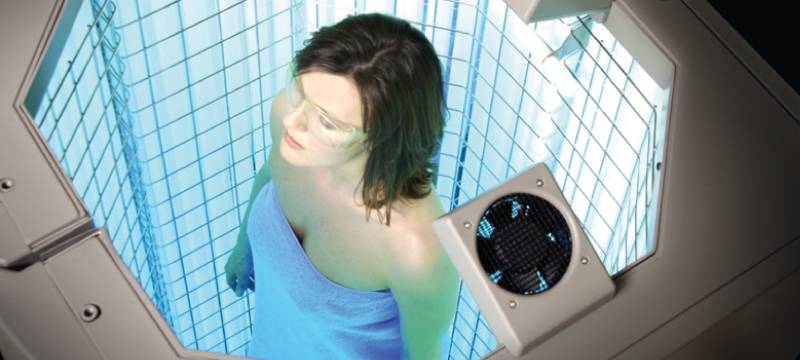Controlling Psoriasis with Phototherapy

If you struggle with psoriasis, have you ever noticed improvements in your skin after spending some time outdoors? Ultraviolet rays, predominately UVB, from the sun can help slow skin cell proliferation and minimize inflammation and irritation.
Light therapy (or phototherapy) uses the same healing principle as sun exposure, but in a controlled treatment that is both safer and more effective.
What is Phototherapy?
Phototherapy, also called Light Therapy, effectively treats symptoms of psoriasis using a narrow band ultraviolet B (NB UVB) light source to expose the skin to ultraviolet light in a controlled manner. It is important to note that the NB UVB range has been studied to be the most immunosuppressive for the skin, with minimizing the harmful effects of broad UV exposure. Regularly exposing the skin to the proper amount of NB UVB rays can clear or prevent psoriasis symptom flare-ups. NB UVB exposure also helps the skin to produce Vitamin D, a nutrient which can help reduce inflammation.
Phototherapy treatments are administered by a skilled dermatologist or other health professionals. The provider calculates precisely how much NB UVB light each individual patient’s skin should be subjected to. This level of oversite increases the safety and efficacy of the treatment as the patient is exposed to a level that improves their psoriasis without causing damage to the skin. Phototherapy allows a skilled provider to tailor each treatment (i.e. increase or decrease the level of UV exposure) to best manage psoriasis over time.
Why not just sit out in the sun?
While sunlight can help with your psoriasis symptoms, getting too much exposure can damage your skin and even worsen psoriasis symptoms. Natural sunbathing is not monitored in a medical setting and is a spectrum of UVA and UVB. Exposure to uncontrolled UV light can significantly increase your risk of skin cancer and photoaging, including wrinkles and sun spots.
What about using tanning beds?
As with natural sunlight, tanning beds are unmonitored and their use can easily lead to photo-damage. Additionally, tanning bed light output is broad spectrum of UVA and UVB, which like natural sunlight, can significantly increase your risk of skin cancer.
What’s the difference between narrow band vs. broad band phototherapy?
Phototherapy can either be narrow band or broad band. Narrow band light therapy uses a synthetic UVB light source to release a smaller spectrum of ultraviolet light whereas broad band use the full range of UVA and UVB rays. UVB rays are most effective in treating psoriasis, so narrow band phototherapy often yields the best results in the fewest number of treatment sessions.
What should I expect during a UVB treatment?
Depending on which areas need treatment your dermatologist may have you cover certain areas and leave others exposed. Patients will stand in a UVB box to expose the skin to UVB rays for a targeted amount of time, ranging from only a few seconds to several minutes.
One of the many benefits of phototherapy is the flexibility of treatment. The phototherapy unit is available during normal business hours, Monday thru Friday. During each session, you check in the front desk, then go back to the phototherapy room. Provided are moisturizers to apply to the affected areas and then the phototherapy unit will prompt you the time of treatment. After the treatment is complete, it is recommended to apply the provided sunscreen to your sun exposed skin before leaving the office.
Your provider and staff will be on site to oversee your treatment and answer any questions you may have.
How many treatments are needed to achieve desired results?
Phototherapy treatments are usually administered two or three times per week, typically seeing results within 4-6 weeks. Patients who consistently undergo treatments as directed by their physician will experience the best results.
What kinds of results are possible?
Narrow band UVB light therapy can completely clear the skin of psoriasis symptoms after 20-25 sessions. Although not all patients clear with phototherapy, the majority of people see significant improvement of their skin, some with remission.
What are the risks or side effects of UV light therapy?
While normal exposure to UV light can cause skin damage, aging, and skin cancer, the risks of those from phototherapy is low as it is monitored by a professional. Common effects of narrow band treatments include mild skin redness, tanning, dryness, and minor irritation/itching. Your dermatologist will work with you to minimize these effects.
Are phototherapy treatments covered by insurance?
Some insurance plans cover phototherapy for psoriasis. You will need to check directly with your carrier to find out if it’s something they will cover for you.

I’ve been struggling with mild psoriasis for many years now. I did photo therapy few years back and it helped. Do you guys accept Aetna health insurance?
Hi Jarek, We do accept most Aetna plans, you can see a list of currently accepted insurance plans here: https://www.westlakedermatology.com/resources/insurance-plans/
Also you could give us a call at 512.328.3376 and one of our representatives can verify your coverage for photo therapy.
Thanks,
WD Staff
I have nail psoriasis. I use several RX topical ointments. Not interested in oral RX. Do you use the photo therapy on nails?
Hi Bonnie, photo therapy on/around the nails can be an effective way to manage symptoms in some instances. If you are in the Austin area, please give us a call to setup an appointment. Our dermatologists can assess your specific characteristics to see if photo therapy will be a good fit!
Thanks,
WD Staff
I’ve experienced great results with light therapy, but it did take awhile. I’d say 20-25 sessions of narrowband UVB and now my symptoms are minimal
Is the Bee Caves office the only location that has this UV LIght maching?
Hi Stephanie,
Great question! Now we also have the treatment at our Round Rock location, which services North Austin, Round Rock, Cedar Park, and surrounding areas.
Thanks,
WD Staff